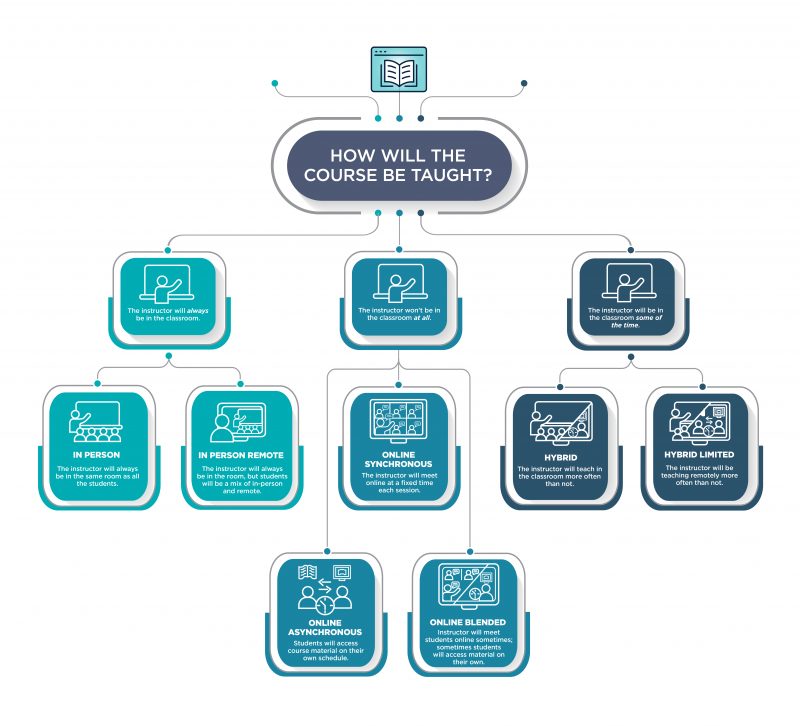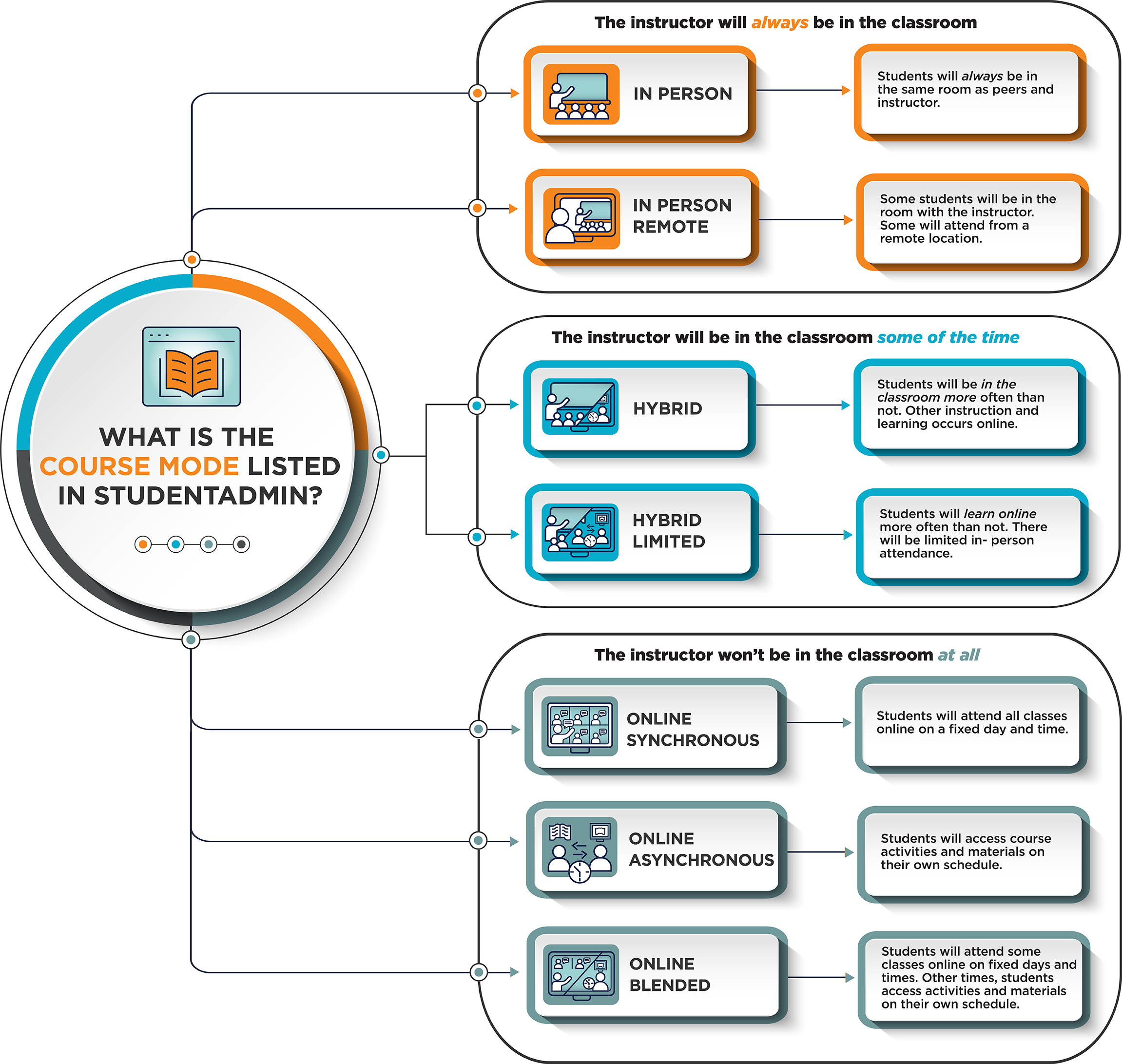Overview
The following is the result of a collaborative effort by UConn's Future of Learning Committee, the Office of the Registrar, and the Center for Excellence in Teaching and Learning to accurately define UConn's course modalities. Here you will find a definition of each modality accompanied by helpful explanations and considerations for effective teaching. Click on the headings below to explore the different options and make informed decisions about the best approach for your course.
Course Modalities:
The following instruction modes went into effect in the Fall of 2023. The official definitions are hosted on the Registrar's website.
- In-Person (P): All instruction occurs on specified days/times and in a specified physical location.
- In-Person Remote (PR): All instruction occurs on specified days/times and at a specified physical location. Remote students will participate synchronously from another UConn campus or remote location as specified by the faculty member.
- Hybrid (HB): A minimum of 50% of instruction occurs on specified days/times and in a specified physical location. This portion of the course will meet in person. The remainder of instruction is delivered remotely, either synchronously or asynchronously.
- Hybrid Limited (HL): Some instruction, but less than 50%, occurs on specified days/times and in a specified physical location. This portion of the course will meet in person. The remainder of instruction is delivered remotely, either synchronously or asynchronously.
- Online Synchronous (OS): All instruction occurs remotely on specified meeting days/times.
- Online Asynchronous (OA): All instruction occurs asynchronously online and there are no specified meeting days/times.
- Online Blended (OB): All instruction occurs online but requires a mix of remote synchronous (specified days/times) and asynchronous online learning.
- By Arrangement' Courses (AR): All instruction is delivered at times and locations determined by mutual agreement between the instructor and the student(s).
Course Modalities Explained
Explanations:
- In-Person (P): This mode is the traditional instruction mode where students are expected to attend all classes and examinations in person. The instructor is under no obligation to offer course materials remotely. (Either synchronously or asynchronously)
- In-Person Remote (PR): This mode captures classes where the instructor is teaching in a physical location where a group of students will be present. Other students not assigned the same physical location as the instructor will attend and participate remotely. This remote attendance can occur in Storrs or Regional campus classrooms or at unspecified locations using web conferencing software. The faculty member will determine how the remote students will attend and participate. Examinations will be conducted in such a manner to support both learning modalities.
- Hybrid (HB): This mode involves all students having both in person and remote learning. There will be scheduled in-person classes which all students are expected to attend. Additionally, there will be remote instruction, either synchronous or asynchronous, which constitutes some (but not most) of the learning time. Examinations can be conducted either in-person or remote at the instructor’s discretion.
- Hybrid Limited (HL):This mode closely resembles the Hybrid model, but the majority of the instruction is conducted remotely. The hybrid limited distinction makes it clear to students that the majority of instruction will be remote and there will be limited in-person instruction. This distinction makes it more transparent for students at the time of registration, but also because this proportion of remote matters to Homeland Security definitions that guide and restrict international students on student visas who may choose to enroll in the course. Examinations may still be given either in-person or remotely.
- Online Synchronous (OS): This mode includes all classes that have synchronous instruction and where all material is available remotely, and required participation is conducted remotely. Examinations can be either synchronous or asynchronous, but students cannot be required to take in-person exams. This allows students to take the courses without being proximal to a UConn campus.
- Online Asynchronous (OA): This mode includes classes with no required synchronous nor in-person instruction. All required instruction and assessments are designed to be delivered remotely. The intention is to allow for students with non-traditional schedules or international time differences to complete their requirements without undue disruption to their schedules.
- Online Blended (OB): This mode is a combination of online synchronous (some part of instruction or assessment will be scheduled and required at specified days/times) and asynchronous. All required instruction and assessments must be available for remote participation by students.
- By Arrangement: This mode is appropriate for clinical placements, field placements, independent studies, internships, and research hours. It is designed to capture classes where the instructor and the student have a dialogue about the expectations of the course. Examinations are to be scheduled by mutual agreement. This list of appropriate classes is not intended to be definitive; rather they serve as examples of appropriate classes for this mode.
Teaching Considerations for Course Modalities
Teaching Considerations for Each Modality
Regardless of course modality, there are fundamentals and best practices of teaching and learning that apply to all University teaching and learning situations. CETL provides faculty resources, training, and services to support faculty in these endeavors. In addition, some modalities require further consideration to reduce challenges and increase the likelihood that students and faculty will have a positive and productive experience. Similarly, consider that a student may receive CSD accommodations (e.g., to attend in-person classes remotely) and how you might adapt your activities and assignments in that eventuality. Below are suggested steps and resources.
- In-Person (P)
- Consult with your department to identify any unique department and school or college expectations and practices for in-person course instruction
- In-Person Remote (PR)
- Determine if remote students will attend from another campus location, a location of their choice, or both
- If students are able to attend from a location of their choice, provide guidance in your syllabus regarding how they will connect (WebEX, Teams, Collaborate) and any technology requirements.
- Review Academic IT's guidelines for Teaching an Online Class with WebEX
- If you will be connecting between classrooms on multiple campuses (e.g., Storrs to Avery Point, Stamford to Hartford and Waterbury), contact Academic IT to request training and guidance for setting up the classroom connections, testing the technology, and notifying support staff at all campuses of the need for tech support.
- Plan ahead to take into account the needs of the students who are not in the classroom with you
- Plan ahead for in-class assessments and any unique requirements for students at remote locations
- Hybrid (HB) and Hybrid Limited (HL)
- Review CETL's guidelines for designing hybrid courses
- Plan for student engagement
- Consider the benefits of flipped classroom methods for your hybrid course
- Contact Educational Technologies for training and guidance on using HuskyCT for online content delivery
- Online Synchronous (OS)
- Review CETL's guidance for remote synchronous teaching
- Contact Educational Technologies for training and guidance on using HuskyCT for online content delivery
- Review eCampus' guidelines for Managing Your Online Course
- Plan for student engagement
- Develop an authentication plan
- Review eCampus Resources for Teaching Online at UConn
- Online Asynchronous (OA), and Online Blended (OB)
- Review eCampus' guidelines for Managing Your Online Course
- Contact Educational Technologies for training and guidance on using HuskyCT for online content delivery
- Plan for student engagement
- Develop an authentication plan
- Review eCampus Resources for Teaching Online at UConn
- Follow a systematic approach to designing and developing your online course
- If your course is part of a fully online degree or certificate program or will be offered in summer or winter terms, contact eCampus for more information on working directly with staff.
- By Arrangement' Courses (AR)
- Consult with your department to identify department and school or college expectations and practices for by arrangement courses
Regardless of mode, using the CETL Syllabus template will help ensure you provide students with important information regarding required technology and participation expectations specific for the modality of the course. Using the eCampus Syllabus Template will help you address specific the needs of courses containing asynchronous online components (e.g., H, HL, OA, OB).
Faculty should ensure that TAs are trained and understand their roles specific to the course modalities.
Quick Links
![]()
Consult with our CETL Professionals
Consultation services are available to all UConn faculty at all campuses at no charge.

